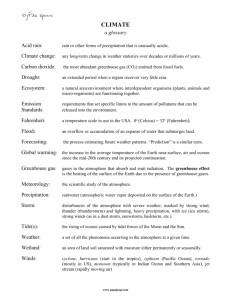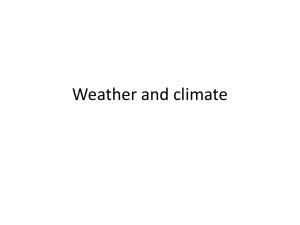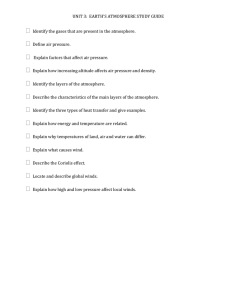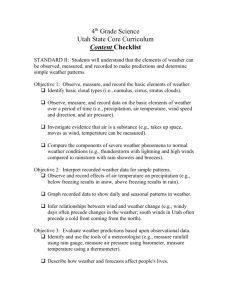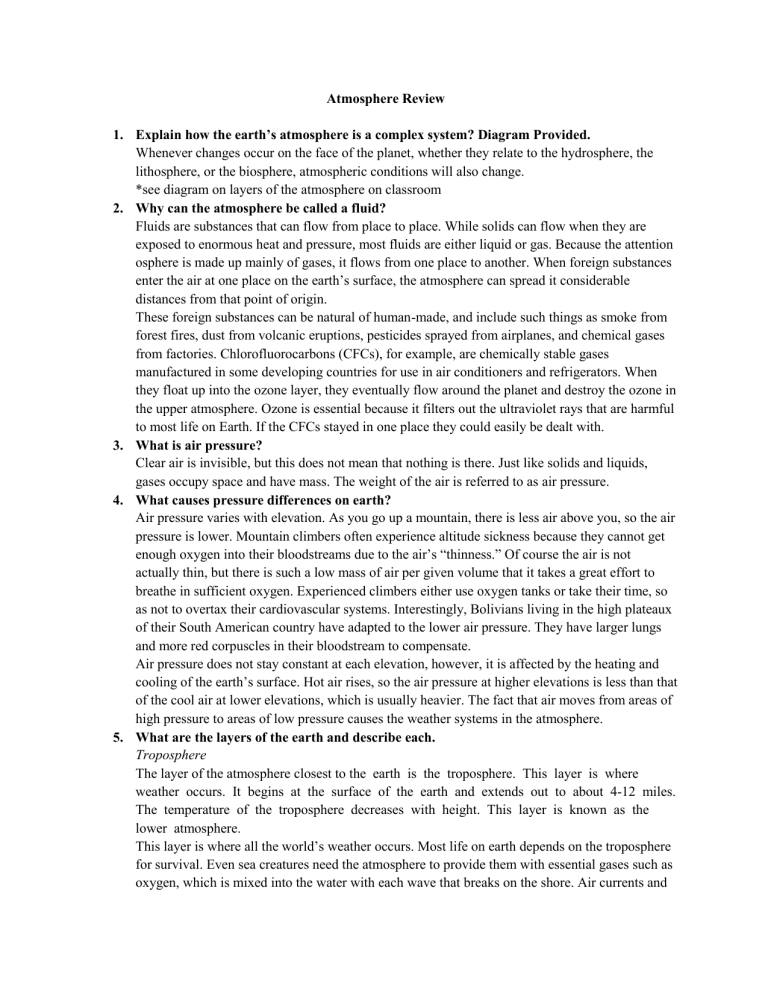
Atmosphere Review 1. Explain how the earth’s atmosphere is a complex system? Diagram Provided. Whenever changes occur on the face of the planet, whether they relate to the hydrosphere, the lithosphere, or the biosphere, atmospheric conditions will also change. *see diagram on layers of the atmosphere on classroom 2. Why can the atmosphere be called a fluid? Fluids are substances that can flow from place to place. While solids can flow when they are exposed to enormous heat and pressure, most fluids are either liquid or gas. Because the attention osphere is made up mainly of gases, it flows from one place to another. When foreign substances enter the air at one place on the earth’s surface, the atmosphere can spread it considerable distances from that point of origin. These foreign substances can be natural of human-made, and include such things as smoke from forest fires, dust from volcanic eruptions, pesticides sprayed from airplanes, and chemical gases from factories. Chlorofluorocarbons (CFCs), for example, are chemically stable gases manufactured in some developing countries for use in air conditioners and refrigerators. When they float up into the ozone layer, they eventually flow around the planet and destroy the ozone in the upper atmosphere. Ozone is essential because it filters out the ultraviolet rays that are harmful to most life on Earth. If the CFCs stayed in one place they could easily be dealt with. 3. What is air pressure? Clear air is invisible, but this does not mean that nothing is there. Just like solids and liquids, gases occupy space and have mass. The weight of the air is referred to as air pressure. 4. What causes pressure differences on earth? Air pressure varies with elevation. As you go up a mountain, there is less air above you, so the air pressure is lower. Mountain climbers often experience altitude sickness because they cannot get enough oxygen into their bloodstreams due to the air’s “thinness.” Of course the air is not actually thin, but there is such a low mass of air per given volume that it takes a great effort to breathe in sufficient oxygen. Experienced climbers either use oxygen tanks or take their time, so as not to overtax their cardiovascular systems. Interestingly, Bolivians living in the high plateaux of their South American country have adapted to the lower air pressure. They have larger lungs and more red corpuscles in their bloodstream to compensate. Air pressure does not stay constant at each elevation, however, it is affected by the heating and cooling of the earth’s surface. Hot air rises, so the air pressure at higher elevations is less than that of the cool air at lower elevations, which is usually heavier. The fact that air moves from areas of high pressure to areas of low pressure causes the weather systems in the atmosphere. 5. What are the layers of the earth and describe each. Troposphere The layer of the atmosphere closest to the earth is the troposphere. This layer is where weather occurs. It begins at the surface of the earth and extends out to about 4­12 miles. The temperature of the troposphere decreases with height. This layer is known as the lower atmosphere. This layer is where all the world’s weather occurs. Most life on earth depends on the troposphere for survival. Even sea creatures need the atmosphere to provide them with essential gases such as oxygen, which is mixed into the water with each wave that breaks on the shore. Air currents and the friction caused by the earth’s rotation make currents in the troposphere the roughest of all layers. Tropopause The tropopause is a traditional layer that separates the troposphere from the stratosphere. Its dimensions vary from about 16 km at the equator to only 9 km at the poles. In the tropopause, the temperature stops falling and stabilizes at about -55C. The turbulence of the troposphere is left behind, and in this layer’s cold, still environment, artificial breathing apparatus and warm clothing would be essential. Stratosphere Above the troposphere is the stratosphere, which extends to about 20­35 miles above the earth's surface. Temperature rises within the stratosphere but still remains well below freezing. Once you passed through the tropopause, you would enter the stratosphere. This layer contains two features that greatly affect people far below; the jet stream, which affects the movement of storms in the troposphere; and the ozone layer, which filters out harmful solar rays. As in the tropopause, vertical air movement is minimal, but there are horizontal currents in this layer known as the jet stream, which guide storm systems. Stratopause In the stratopause, another transition zone, the temperature stops increasing as the stratospheric ozone thins out with altitude. This layer is the beginning of the outer atmosphere. Mesosphere From about 35 to 50 miles above the surface of the earth lies the mesosphere, where the air is especially thin and molecules are great distances apart. Temperatures in the mesosphere reach a low of ­184°F (­120°C). The stratosphere and the mesosphere are the middle atmosphere. Mesopause The temperature stabilizes, and then rises once again. The air is so thin here that it would seem as though you were already in outer space. Thermosphere The thermosphere rises several hundred miles above the earth's surface, from 50 miles up to about 400 miles. Temperature increases with height and can rise to as high as 3,600°F (2000°C). Nonetheless, the air would feel cold because the hot molecules are so far apart. This layer is known as the upper atmosphere. Exosphere Extending from the top of the thermosphere to 6200 miles (10,000 km) above the earth is the exosphere. This layer has very few atmospheric molecules, which can escape into space. 6. What is rotation and revolution? Planet Earth is constantly in motion. It is spinning on its axis, tilted at 23.5 degrees from the vertical, while at the same time revolving around the sun in an elliptical orbit. These two actions result in an unequal distribution of light at any one time. Parts of the earth facing the sun get daylight while parts turned away are cloaked in darkness. The earth rotates in a counter clockwise direction every 24 hours (actually, the time period is slightly less), resulting in day and night. 7. What causes the four seasons? The Earth is tilted so as it rotates around the sun over a year different areas receive different amounts of sunlight at certain times during the year and therefore the temperature changes creating the four seasons. 8. What are the four seasons and describe the sun’s location in each? Because the earth is tilted, the lengths of day and night change with the seasons. When the earth is tilted toward the sun in summer, the sun’s rays shine for a longer period of time each day. In winter, the earth is tilted away from the sun and the amount of sunlight received each day decreases. The only exception to this rule is at the equator (0 degrees latitude) where day and night are poth 12 hours long every day, all year. As you move away from the equator, the lengths of day and night become more extreme. 9. Illustrate the global wind diagram and explain how each of the following are created a) Trade Winds The trading ships of long ago used the force of the wind energy to get from one port to another hence the name, the trade winds. In tropical climates where hot, muggy weather is common, refreshing winds off the ocean cool coastal regions. It is small wonder that most tropical cities are either coastal or in the cooler mountainous regions. b) Geostrophic Winds High atmosphere wind that rotates the planet also called the jet stream. c) Hadley Cells Compact wind rotation at a certain location on the planet. d) Westerlies The belt of prevailing westerly winds in the mid-latitudes of the northern and southern hemispheres. e) Polar Easterlies In polar regions, frigid arctic air flows out over the polar ice sheets. The prevailing winds, called the polar easterlies, deflect once again to blow from the northeast in the Northern Hemisphere and the southeast in Southern Hemisphere. As you can see, the earth’s rotation and the Coriolis effect greatly modify the cellular model of prevailing winds. f) Horse Latitudes A belt of calm air and sea occurring in both the northern and southern hemispheres between the trade winds and the westerlies. g) Prevailing Winds Prevailing winds are the winds that normally flow in any given place. Most Canadians are familiar with the westerlies. These are the winds that prevail in the middle latitudes. In polar regions and in the Tropics, winds tend to blow from the east. Prevailing winds blow as they do because of the dynamic forces of convection and the Coriolis effect. h) Doldrums Directly over the equator, there is little to no wind because the air rising in updrafts. These doldrums are characterized by violent storms in the late afternoon, as convection rainfall returns some of the moisture that evaporated from the sodden ground and the humid jungles. i) Coriolis Effect 10. 11. 12. 13. Prevailing winds are also influenced by the Coriolis effect. Northern Hemisphere winds are deflected to the right while Southern Hemisphere winds are swung to the left by the spinning of the earth on its axis. Define wind and explain how it is created? Wind is the movement of air from one place to another across the surface of the earth, so it is a prime example of kinetic energy in the atmosphere. Air currents are actually the result of differences in surface heating. When a substance such as air is heated, it expands because the molecules move rapidly, causing the space between them to increase. This causes the molecules to spread out and become less dense, thereby causing the air to rise. Therefore, when one part of the earth is heated more than another, air rises over the warm surface and cooler air rushes in to fill the void. This action creates wind. Explain and illustrate land, sea breezes and monsoon winds. Sea breezes is any wind that blows from a large body of water toward or onto a landmass. Land breezes are characterized as the flow of wind from land to water usually at night, can alternate with sea breezes. Monsoon winds are the seasonal reversing winds of the Indian Ocean and Southern Asia blowing Southwest in the summer and Northeast in the winter. What are the different kinds of precipitation? Explain each. Rain -liquid deposits falling from the atmosphere to the surface -with a diameter > 0.5 mm -max. Size: about 5-7 mm Snow Water vapour depositing into flakes below freezing Hail Golf ball sized hail is composed of over ten billion accumulated water droplets that are held in the cloud for 5 to 10 minutes with 88 km/h updrafts. If you were to cut one in half the layers in which it formed would resemble those of an onion. Sleet Water droplets that freeze when they touch the ground surface, turning to ice pellets. Freezing rain When water droplets reach a surface of below freezing point, so the rain quickly turns to ice. What differentiates it from sleet is that freezing rain has already turned to ice sooner than that of sleet. Describe and illustrate the three different types of precipitation (Orographic, Convectional, Cyclonic) Covectional When the land warms up, it heats the air above it. This causes the air to expand and rise. As the air rises it cools and condenses. If this process continues repeatedly then rain will fall. -Humid thunderstorm that would generally occur in the summer. Orographic Orographic precipitation results when warm moist air moving across the ocean is forced to rise by large mountains. As the air rises, it cools. Cold air cannot hold as much moisture as warm air. As air cools, the water vapour in the air condenses and water droplets form. Clouds form and precipitation (rain or snow) occurs on the windward side of the mountain. The air is now dry and rises over top the mountain. As the air moves back down the mountain, it collects moisture from the ground via evaporation. This side of the mountain is called the leeward side. It receives very little precipitation. -Occurs in Mountain areas. Cyclonic Cyclonic or frontal precipitation results when the leading edge of a warm, moist air mass (cold front). The molecules in the cold air are more tightly packed together, and thus, the cold air is heavier than the warm air. The warmer air mass is forced up over the cool air. As it rises, the warm air cools, the water vapour in the air condenses, and clouds and precipitation result. This precipitation is common in Atlantic Canada. -Regular rain storms that occur regularly. 14. Describe how tornadoes form. To have a tornado, a funnel cloud must be formed due to strong convection currents due to surface heating. Cold front interacts with warm front and produces an unstable front. 15. What is the Fujita Scale? What is the intensity measured by? The Fujita scale is what ranks a tornado. Tornadoes are ranked based on their wind speeds and intensity is measured by the amount of damage caused. F0 64-115 km/h Broken chimneys, trees and signs. F3 266-330 km/h Roofs torn off, trains overturned and most trees uprooted. F5 401-500 km/h Houses picked up, cars carried away, hundreds of miles, steel and concrete building destroyed. F6 501-600 km/h All man made objects destroyed- none ever experienced. 16. Where are tornadoes most common in Canada and USA? In the USA, Kansas has the most tornadoes and in Canada, Alberta and Southern Ontario. 17. What is the relationship between the percentage of tornadoes and the deaths associated with tornadoes? Percentages of Tornadoes Percentages of Deaths FO-F1- 74% FO-F1- 4% F2-F3- 25% F2-F3- 29% F4-F5- 1% F4-F5- 67% 18. Describe how hurricanes form and move. Hurricanes rotate in a counter-clockwise direction around a “eye” in the Northern hemisphere and clockwise direction in the Southern hemisphere. Hurricanes form by gathering heat and energy through contact with warm ocean waters. 19. What is a hurricanes fuel source? Evaporation from the warm ocean water increases the power of a hurricane. 20. Illustrate the makeup and location of hurricane formation? 21. What is most of the damage from a hurricane caused by? Storm surges are frequently the most devastating part of a hurricane. As a hurricane’s winds spiral around and around the storm, they push water into a mound at the storm’s center. This mound of water becomes dangerous when the storm reaches land because it causes major flooding along the coast. -Mud Slides -High Speed wind gusts -Flooding 22. What are the five classes of hurricanes? Category km/h Surge 1 Minimal 120-152 1.6m 2 Moderate 153-176 2.8m 3 Extensive 177-209 4.1m 4 Extreme 210-250 6.4m 5 Catastrophic 250+ 7m+ 23. Describe the effect Katrina had on New Orleans. 24. What makes New Orleans a risk to flooding? New Orleans is basically a bowl with the Mississippi River Bank on one side and the Lake Pontchartrain Shoreline on the other. 25. What is climate vs. weather? Climate refers to the average weather conditions that are season to season, while the weather is day to day temperature. 26. What are the 5 factors that affect climate? Explain each. Location- the amount of solar radiation and the angle at which the sun's rays hit the surface of that place. Elevation and Relief - the height above sea level influences temperature because of air pressure (think of flying in an airplane and why some people feel sick. Or cabin pressure) 27. 28. 29. 30. 31. 32. 33. 34. 35. Proximity to bodies of Water - moderate temperatures ( i.e takes much longer to cool and warm) Ocean currents - the movement of heat from the equator to poles warms shorelines and cools others, influences precipitation patterns. Winds and Air Masses - air masses take on the characteristics of the area where it formed. Air masses forming over the ocean (called Maritime Air Masses) will carry moisture. Air Masses forming over the continents (called Continental Air Masses) will be dry. What are microclimates and urban microclimates? Microclimates are a climate of a small restricted area, differing from climates surrounding the area. An example of urban microclimates are in urban areas where concrete, asphalt, and brick absorb the sun’s energy and radiate heat to the ambient air. What is Koppen Climate System? It is a widely used climate classification system. It divides climate into five main groups. What are the five Major Climate Groups associated with Koppen? Where is each located? A (tropical) around the equator, B (dry) in deserts, C (temperate) where summers are mild and winters are not too cold, D (continental) far away from sea, long cold winters and short hot summers, E (polar) long periods of extreme cold, far away from equators What is a freezing rain storm? Ice storms are when the fall of freezing rain persists for a long period of time, and accumulates on roads, trees and anything else that gets in its path. Ice storms typically begin with snow. The snow changes briefly to sleet and then to rain that freezes on impact, coating all exposed surfaces with a growing layer of ice. How is freezing rain formed? Frozen precipitation in the form of lumps of ice, is created when rain is forced above the freezing level by a thunderstorm updraft. What damage did the 98 Ice Storm cause? The storm left people in Montreal without power or hot water for more than 30 days and the temperature dropped to -30 degrees C. At least 30 people died. On the darkest day, three million people - roughly half of Quebec’s population - were left without electricity, and thousands were trapped in their homes, waiting to be rescued and thousands fled to shelters. The storm caused an estimated 3 billion dollars in damage. How is hail formed? A hailstone the size of a golf ball needs over ten billion supercooled droplets to be accumulated, and it must remain in the storm cloud for 5 to 10 minutes and be held up by updrafts over 88 km/h. When you slice a hailstone through the center they resemble an onion with the layering and the layers on the stone determine how the ice was gathered during the different stages of the hailstones growth. What damage does hail cause? In 1991 there was a hailstorm that caused around 450 million dollars in damages in Alberta. Most of the damages happened to things like crops, vehicles, buildings, and roofs. What benefit does hail and freezing rain have? Ice storms and hail can be beneficial as they can knock down dead branches, release seeds, and provide nesting and sleeping shelters for birds and animals.


